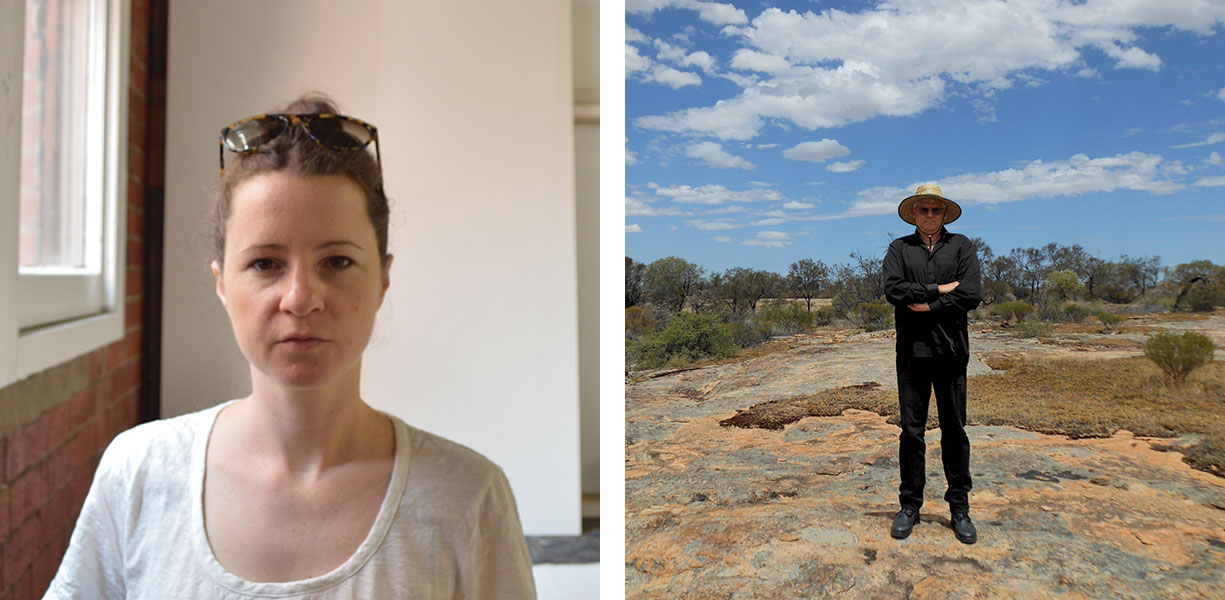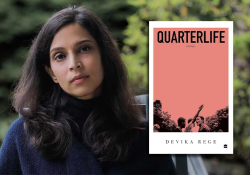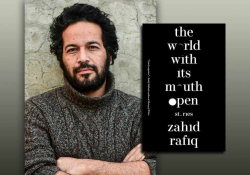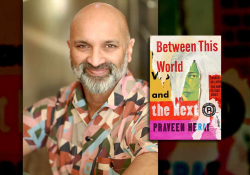Critiquing Colonialism from Within: A Conversation with Helen Johnson & John Kinsella

In her densely layered, often two-sided canvases, Australian artist Helen Johnson invites viewers into an ongoing critique of Australia’s colonial legacy. With exhibits in London, Los Angeles, and New York City, her work has reached international audiences. Poet and writer John Kinsella conducts a similar critique in his work. From wheat-belt Western Australia, Kinsella has written more than forty collections of poetry and also fiction, plays, and nonfiction. Kinsella is a Fellow of Churchill College, Cambridge University, and professor of literature and environment at Curtin University, Western Australia. Here they discuss what it means to critique a system while necessarily benefiting from it, landscape as a Western construction, and how a Kantian experience can “trouble conventional perceptions.”
Michelle Johnson: Helen, you and John have both been identified as anticolonial artists. In your work, perhaps this is easiest to identify in Warm Ties, your show earlier this year in central London, making it a good starting point. How did you choose the title of the exhibit?
Helen Johnson: I called that exhibition Warm Ties in reference to the diplomatic use of the term, to denote friendly relations between two countries—the way I think about it, it is a fraught term, it’s like a thin surface with many complexities lurking underneath it. This seemed fitting, since the focus of the exhibition was the cultural attitudes that the British brought to Australia when they colonized it, ways in which those attitudes solidified into power structures, and ways in which they persist.
I was also thinking about the term more literally as ties around the necks of men; there is some imagery in those paintings of ruling-class men from the early years of the colony of Port Phillip (now the Melbourne region) falling about drunk after boozy lunches or dinners. I imagine them sweating under their collars.
I want to add that I have reservations about the term “anticolonial” and the way it has been applied to my work. I feel it’s important to critique colonialism from within it, but when you are a beneficiary of it as I am, as a white person living in Australia, I don’t think you can say you are anticolonial, because it seems to imply an outsideness or an absolution, when in fact you are invariably part of it.
John Kinsella: This is interesting. I agree that as an ongoing beneficiary of an ongoing colonialism, we should avoid all suggestions of being outside the invasiveness. However, I still think you can be anticolonial by divesting one’s self of the privileges accorded the colonizer and redirecting the benefits. I consider myself anticolonial in my life and writing, though overtly acknowledge that I am part of an ongoing process of colonial/ization/ism. Writing (in my case) or articulating in general from within is not to condone that “within,” to my mind. In fact, isn’t it surely incumbent on the beneficiaries to disrupt the flow of (stolen/pillaged) benefits to themselves? I think we accord in a desire to undo the language of colonialism, and clearly to challenge colonialism’s legacy and ongoing nature, but might we see the discussion around what we’re doing in slightly different terms? Of course, I am not talking specifically of how critics have applied the term to your work, Helen, and that’ll have its own dynamic—I am talking “generically.”
Helen: I agree regarding the necessity of redirecting the benefits, though it’s a big question as to how this is achieved; if you are talking about redirecting financial resources, there’s the whole question around “to whom?” To an individual, an organization, a land council—but then the politics of each of those is bound to be complex. “Writing (in my case) or articulating in general from within is not to condone that ‘within,’ to my mind”—I agree with this too. I think that if the realities of colonizing processes are framed as an “Indigenous issue,” it is a failure of responsibility. It’s everyone’s problem. This is all aside from my reaction to my work being referred to as “anticolonial”—“ferociously anticolonial.” What’s more, I thought that was hyperbolic and not really true to the work, which I think about as picking at already fraying seams, a voice in a conversation.
John: Yes, it is a question of how, and it seems that it is best done in consultation with different elders and representatives within different groups. I have donated to support legal struggles against mining companies and also to medical support facilities in community, but a “donation” can also be a patronizing process if it’s done in a way that seems more about placating guilt than real outcomes. Any community is going to be one of conflicting views, so it’s also a matter of working with community who are okay with where an outsider is “coming from.” The point is land return and autonomy, and sometimes the best way toward these is direct, peaceful, activist intervention against the colonizing bodies themselves.
Helen: I attended a really interesting discussion panel at the Australian Center for Contemporary Art last year between Paola Balla, Hannah Donnelly, Kimberley Moulton, and Léuli Eshrāghi. They were in part discussing the question of whether decolonization is really the aim and proposing an understanding of Indigenous continuities that run through and reconfigure themselves, as opposed to the idea of colonization as a rupture that cut those cultural continuities, and that getting outside the colonial frame is the only point at which something is “achieved”; rather, that this continuity and adaptability is something to be celebrated. I felt like this was a beautiful and optimistic conceptualization.
If community has to do all the work of fixing not only the physical destructions but also the creative and (im)moral disruptions, then the oppressive colonial forces have things right where they want them - john kinsella
John: Yes, it can be, and I am a believer in anything that supports self-definition, intactness, and acknowledgment of continuance done in conjunction with ongoing restitution from colonizers and non-Aboriginal people/s. The point is, if community has to do all the work of fixing not only the physical destructions but also the creative and (im)moral disruptions, then the oppressive colonial forces have things right where they want them—under control, nonthreatening to the capitalist-military status quo. For me, this is an ongoing process heavily associated with environmental activism. My life’s purpose is restitution of people’s rights but also the rights of “nature.”
Sometimes these things clash, but actually not as often as the rapacious would have us think. Environmental protection in consultation with Indigenous peoples is the approach I believe is most just. And, as an anarchist, I am a believer in consensus, community, decentralization (but with universal human rights), and natural (nonviolent) justice. So, I am “different” in attitudes from many of those I advocate for (if they want my advocacy—it isn’t a forced thing!), but conversation is always a way forward to try and “reconcile” the most just outcome for all.
Michelle: Landscape is something you may have in common in your work. Helen, you incorporated invasive plants into your painting Bad Debt. How were you using the landscape?
Helen: I thought of Bad Debt as being to do with the idea that theft can constitute not only a taking away but a bringing in—that invasive species are part of the legacy of our collective colonial theft. A reshaping as well as a plunder. The plants depicted were all included on the invasive species list in Victoria and were mostly found in the immediate vicinity of my studio in Eltham on Wurundjeri country.
I think the whole idea of landscape is a cultural construct, as distinct from country; landscape suggests a projection, a point of view, an inherent Europeanness. – helen johnson
I think the whole idea of landscape is a cultural construct, as distinct from country; landscape suggests a projection, a point of view, an inherent Europeanness. One of the first large-scale figurative paintings I made, around 2004, depicted two figures, one traversing a constructed and anthropomorphic “landscape,” the other gazing at a “painting” on a wall that appeared to be a cartoonish, sort of psychedelic landscape, but was actually an illustration of a cross-section of a human brain from a textbook. I guess it was my first attempt to talk about this idea of landscape.
John: This is absolutely the case to my mind. Landscape is a Western construction of human interaction with place—its reshaping to suit “development.” I wrote a book on this issue called Disclosed Poetics: Beyond Landscape and Lyricism, a couple of volumes of collected essays entitled Spatial Relations, and most recently a book entitled Polysituatedness that consider multiple conceptualizations of place in the self at any given time.
All poems or artworks or pieces of music “require” an interaction between not only people but the spaces in which they are seen/heard/read/experienced and also created. These elements are in constant flux. I feel that if we work with an awareness that once placed “in public” (brought into increasingly broader conversations, we hope) a piece will not only have a life of its own but will be open to manipulation by colonial-capitalist forces (colonialism isn’t always capitalist, but it certainly is in Australia!). We can think about “strategies” (I reclaim that as a pacifist and not a militarized metaphor!) of presentation and conversation that allow for the piece to adjust to the conditions, to keep on resisting. For me, no poem or artwork of any kind has closure—none at all. It is a living entity that will go on in some form or another.
One of the exciting things about collaborative work is that it is always multiplicitous, and its directions often surprising. Working with Yamaji poet and artist Charmaine Papertalk-Green on False Claims of Colonial Thieves has shown me that a work, in having a life of its own, in being able to speak across communities and geographies, never has to have its vital advocacy for a particular community “diluted” by an interaction with someone from elsewhere (see WLT, Sept. 2018, 87). Common purpose is realizable, especially when the wrong being resisted is such a clear one: defenses and mechanisms of colonialism are inevitably corrupt, unjust, and self-serving.
But out of our depictions of the wrongs, and often the horror, and the invasiveness of, say, the mining industry, we also find room for celebrating strength, presence, the intense depth (and flexibility) of culture, and the generative wonder of conversing. We yarn. Without a conversation, there’s nothing. No matter how angry we get, we still yarn. And we still listen. And I see that as my primary job as a poet—to listen and offer what I hear in a variety of self-scrutinizing ways. And I think that’s what you do, too, Helen!
Michelle: Helen, I’d like to go back for a moment to what you said earlier about “picking at fraying seams” in an ongoing conversation. In your book Painting Is a Critical Form, using Juan Davila’s work as an example, you write about how an artist can use aesthetics to operate beyond what might be thought an aesthetic approach to “trouble conventional perceptions.” Do you employ aesthetics to “question agreed meanings in matters beyond painting itself”? Is this a way of picking at those already-fraying seams?

I am interested in artworks that employ this as part of a trajectory and then flip it back or lead the viewer into thinking differently about whatever they’ve experienced. So you are drawn in on an aesthetic level and then find yourself faced with something else on a cognitive level. – helen johnson
Helen: Michelle, that’s a really clear understanding of the argument I put forth in the book—I think about this approach to aesthetic experience as a means to use its mechanism as a tool, in a sense, so requiring some degree of distance from it. When I talk about aesthetic experience I mean it in the Kantian sense. There are of course many problems with Kant’s thought from a contemporary perspective, but one aspect of his account of aesthetic experience that I agree with (and also think is widely misunderstood) is the idea that this feeling of universality which for Kant accompanies an experience of beauty is inherently subjective, though the subject may not experience it as such; so a person can believe that what they think is beautiful must be beautiful for everyone. This for Kant is a space from which critique springs. I am interested in artworks that employ this as part of a trajectory and then flip it back or lead the viewer into thinking differently about whatever they’ve experienced. So you are drawn in on an aesthetic level and then find yourself faced with something else on a cognitive level. It’s a means to lure people into thinking about ideas they may otherwise be resistant to.
I think Davila achieves this in his work, as does Martin Kippenberger. It’s something I try to do with my own work. I don’t know if it succeeds, but it’s a reason why the paintings are so layered up with different registers of imagery, which proceed from the initial aesthetic encounter to reveal themselves and complicate that first experience. I feel I should qualify, in relation to this, that when talking about Kantian aesthetic experience I am talking about the experience of an artwork, rather than of nature, or of producing an artwork in nature—it is the former that is connected to critique. This I find potentially useful for reckoning with ourselves, our constructs.
I am always a little wary of the notebook, the recording device, or the canvas on the edge of the salt lake, in the bush, on the beach looking out to “the rest of the world.” – john kinsella
John: Kant “contextualizing” particularly interests me as I have reread the critique over the last year and have written a bunch of poems that configure and question how the “Western eye” accesses knowledges of place it seems to naturally assume are there for it to access—that what’s inherent from it “elsewhere” can be complemented with “experience” to validate its viewing and translating of this into writing/art/music, etc., which is a problem for me. I am always a little wary of the notebook, the recording device, or the canvas on the edge of the salt lake, in the bush, on the beach looking out to “the rest of the world,” though I myself have carried many such notebooks and made many notes. It’s a complex argument, of course, but in a nutshell . . .
Helen: Yes, that idea of “experience” is foundational to colonial art, arguably ongoing. That gaze is a form of ownership, a strong one. I would be interested to read your poems on this subject.
John: There’s a whole series of these poems—some will be out in a book early next year, but the rest are ongoing.
July 2018
Read a poem by John Kinsella from this same issue.















